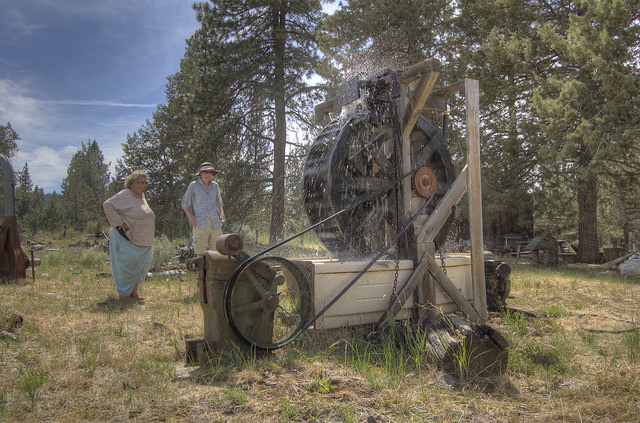The perpetual futility in trying to circumvent the laws of physics through attempts at building the perpetual motion machines
In my first year in college, I had a mechanical engineering student as a roommate. He spends his spare time drawing up various blueprints and building prototypes of a perpetual motion machine. He was so passionate about it that it earned him the nickname, The Perpetual Motion Machine of the First Kind. I agree it was a mouthful, but if you have as much time as we do in our first year in college, you can pronounce that name in a heartbeat.
Flickr Image Licenced under CC BY-SA 2.0 Source: Water wheel-driven gasoline-making perpetual-motion machine picture by Darron Birgenheier
Just like its name says, a perpetual motion machine is a machine that will run (or spin) forever without the need for input. The classic perpetual motion machine does not just spin; it produces useful work. That energy should be enough to overcome losses in the system such as air resistance, friction, etc.
That invariably means it produces more energy than is put in and can run (without additional energy input) until the machine fails.
The machine sometimes is referred to as "free energy machines." They create energy. But is it possible to build a machine that runs forever without the application of external force? Or are they the snake oil salesmen of the engineering world?
Let us find out.
Past attempts at building a perpetual motion machine
History is an excellent place to start in the quest for a perpetual motion machine.
Going back to the 12th century, in 1159, an Indian astronomer and mathematician known as Bhaskara the Learned invented the wheel. The wheel design has curved reserviours filled with mercury. The mercury was expected to flow to one end and make it heavier than the other side of it, thereby giving wheel, known as Bhāskara's wheel the ability to forever move without the supply of an external force.
Other design of perpetual motion machines takes a form or layout of this Bhaskara's wheel. For instance, the curved wheel with ballbearing staggered across the spokes to make one side heavier than the other to induce rotation.
In the 17th Century, the Irish chemist, natural philosopher, and physicist, Robert Boyle, who is famous for his work on gases, especially the one named after him, Boyle's Law, has an idea for a perpetual motion machine.
The design is to have a flask that freely replenished the water on it through the syphon.
The flask and its syphon are meant to make forever water flow. Unfortunately, this like other attempts at building a perpetual motion machine did not work. It is impossible because the syphon needs its "output" to be lower than its "input".
The self-flowing flask is a flawed system that involves the hydrostatic paradox.
If you had made the mistake of leaving a towel dangling from a full bath of water, you will notice you would have a wet floor. The water through capillary action will climb upwards (same way water flows from ground through the roots to other parts of a plant) through the towel. Some inventors tried to use this concept in creating the perpetual motion machine in the forever flowing water.
The hydrostatic paradox looks at the situation where the small quantity of a liquid will balance a large amount of liquid, a subject often suggested for the actualisation of perpetual motion.
Sadly, this does not work. The paradox stems from the fact that it seemed like the perfectly reasonable thing to occur. But instead the Aristotelian principle of "water finding its level" is what happens. That is the water on the left and right of the flask attained the same level and remained that way. A capillary action that is strong enough to draw the water over the syphon will also keep the water from flowing off the syphon.
The problem with all the ideas brought up for a perpetual motion machine is that violate one crucial law of physics: the principle of thermodynamics. It describes the relationship between various forms of energy.
The first law of thermodynamics which states that energy cannot be created or destroyed but can only be transformed (changed) from one form or the other.
In other words, it is impossible to get more output energy than the input. The fundamental principle of perpetual motion machine is that you can get more out than you put in. That was a flawed physics principle.
So when next someone approaches you with the idea to finance his next project of the perpetual motion machine, remember the first law of thermodynamics which states that you cannot get something from nothing and tell the "inventor" a no. You can thank me later.
References
If you write STEM (Science, Technology, Engineering, and Mathematics) related posts, consider joining #steemSTEM on discord here. If you are from Nigeria, you may want to include the #stemng tag in your post. You can visit this blog by @stemng for more details. You can also check this blog post by @steemstem here and this guidelines here for help on how to be a member of @steemstem. Please also check this blog post from @steemstem on proper use of images devoid of copyright issues here.




Reading this post of yours made me remember physics back then in school and to think one can articulate such as if they still had physics in their daily curriculum tripped me. Well-done @greenrun
Thank you.
Science is the real deal...
But the plump lady stares like its working...
It works :)
The question is, how long will it work?
Oh! I got it now. Her hands were on her waist.
The law of physics is truly wonderful and can not do anything without recourse to the law of physics
Well, that's one of the reasons why there are laws.
Science is the soul of life, I will just need to come here and learn new things, great job man putting this together is no job for kids.
Its amazing how much science can be applied to real life. There must be input before there can be output. And we cannot give what we don't have.
Thanks for this post.
Thanks for reading.
You just can't give what you don't have now. That's a life law.
I am not a science person. Science makes me drowsy but I think I liked some topics in biology.😉 but you seem to make it easy for me to grasp. Where were you when I was battling in secondary school?
If scientists and phycists know the law of thermodynamics, why do they still try to make this perpetual motion machine?
How can an interesting subject like science be boring to a point of getting you drowsy? It's pretty interesting my end :)
It has never been interesting....
Well you try to make it so, sometimes you succeed, other times i just appreciate the application.
Your blog is just amazing @greenrun
@warpedpoetic i understand how that feels
It wasn't for me back in secondary school but you make it interesting though.
You are really a good science student. Keep it up.
Hi @gloglo, thanks for dropping by.
If a perpetual motion machine works, I'll definitely make humans stay alive without eating or drinking.
Science is fun...
Hello, that is another wonderful perspective :)
Thank you....
Nice one from you again..
Your post has being so educative..